|
| |
We offer complete forest management services blending economics and biology based on the Landowners objectives.
Our Forest Technicians will walk your property and develop a Management Plan based on the physical attributes of the property and the landowner's objectives. This plan will consist of a description of the different stands of wood as well as a prescription for the type of treatment best suited.
In conjunction with the Provincial Forest Service, and the Forest Enhancement program, we can offer a number of services to improve your woodland for future generations while supplying a steady stream of income for the landowner(s).
Services Offered:
MANAGEMENT PLANS - Property is drawn on to aerial photography and delineated into the different stand types. Property is then cruised and a description and subsequent prescription for each stand is made based on the physical attributes and landowners objectives. Information is compiled into a comprehensive plan, which will identify and schedule work for a ten-year period.
HARVESTING - Mature stands identified in the management plan can be harvested by a variety of methods. Stands that are even aged and over mature such as old-field white spruce are best treated as a clear cut leaving any healthy hardwoods standing for wildlife and seed dispersal. We try and recreate a diversified stand by planting a variety of species as well as encouraging any natural trees, which might grow in the area. Stands that are younger and with some diversity in species and age class are better treated by selection or patch cutting.
REFORSTATION - Harvested areas that do not have adequate natural regeneration should be reforested with new seedlings. We encourage diversity in the stand as well as promote higher value climax species such as white pine and red oak versus monocultures of low value commodity species such as black spruce.
PLANTATION MAINTENANCE - Reforested stands will require maintenance to ensure that the target species thrive by the removal of unwanted species. We recommend using manual maintenance whereas an operator with a spacing saw makes the decision on which tree to cut and which to leave. This will create a healthy mix of hardwoods and softwoods versus a chemical maintenance whereas all hardwoods are killed with no thought to species selection or optimum spacing.
THINNING - Reforested and/or naturally occurring stands benefit from a pre commercial thinning at an early age whereas crop trees are identified and spaced as to assure optimum growth with minimum branching. Poorly formed trees as well as unwanted species are also removed at this time. The next thinning is a commercial thinning whereas the trees are spaced again for optimum growth and the trees cut are removed and sold commercially. This provides the landowner with some income from the stand as well as the improvement to the residual trees.
This treatment can be done a number of times prior to the final harvest.
PRUNING - One of the most underutilized and most valuable treatments is the pruning of the branches of crop trees. By removing the branches from the merchantable portion of a tree stem, this transforms what would be the growth of knotty wood to the growth of clear wood, void of knots. This clear wood is highly sought after in the veneer and wood manufacturing business and increased the value of the trees significantly. The knowledge on wood species and grades of logs and lumber is greatly enhanced by the experience learned form affiliated Company, Royalty Hardwoods Ltd. www.royaltyhardwoods.com which is a saw milling, kiln drying and wood products manufacturing business.
Roseneath, Prince Edward Island
PO Box 30 Georgetown, PE
Canada, C0A 1L0
902-838-3013
www.greenislepei.com
martinus@greenislepei.com
| |
| |
 | |





